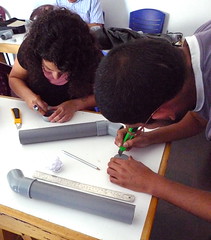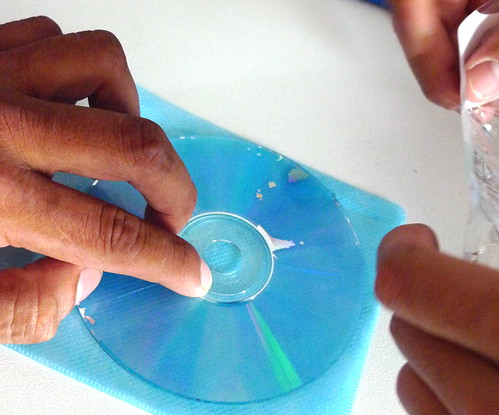A couple weeks ago, Nadya Peek (of the Center for Bits and Atoms) and I led a two-day workshop at Escuelab, in Lima, Peru. Organized by Escuelab(.org) and FabLabLima(.org), the workshop introduced basic visible and infrared spectrometry and participants built their own spectrometers from PVC tubes, digital cameras, and discs cut from blank CD-ROMs.
The original design for the DIY spectrometer came from the Inter-University Center for Astronomy and Astrophysics in Pune, India and the use of a PVC angle joint was a great tip drawn from MAKE Magazine's October issue. We made 10 spectrometers and spent some time in Plaza San Martin testing them with light reflected off of trees, flowers, stone, and other things in the bright sunlight. The online spectral analysis tool is in prototype form, but you can browse the spectra at spectrometer.publiclaboratory.org
For Day 2, people brought samples of materials we wanted to analyze -- for example, I brought green and yellow leaves and Luis brought a slice of pineapple. We were also eager to test Inca Cola, the classic Peruvian soft drink. We hoped to take transmission spectra of most of these -- measuring the sunlight passsing through them, rather than reflecting off of them. We also took baseline sunlight spectra and a transmission spectrum of a plastic cup which we used to hold liquid samples.
Nadya found that full-spectrum LEDs are available online, which should help to standardize the readings we get for transmission spectra. Other future plans include building a hyperspectral camera using a video camera with one of our spectrometers, and launching a spectrometer on a balloon to do full spectral scans from an aerial platform. We have a long way to go to identify anything with our instruments, but we're getting much better at building them, and we're starting to build a database of samples. One major block is the range of wavelengths we can measure, which is currently between about 400 and 1200 nanometers. To get outside that range we're going to have to get creative with new sensors, as the CCDs in digital cameras won't go far outside that range.
For the time being, I did some tests with our infrared-modified camera and managed to produce NDVI and NRG images of plants in Plaza San Martin. In the next few days we're planning to do an infrared/visible light balloon mapping session at the Universidad Nacional de Ingeniera, which hosts the FabLabLima group.





0 Comments
Login to comment.